New Haven, CT
Home MenuFair Haven Completed Commissions
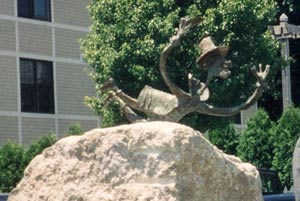 Seaman Sculpture
Seaman Sculpture
Artist: Karen Rossi
Date: 1993
Material: Bronze and Stony Creek granite
Location: Quinnipiac Park near the center of the Park (stolen: only granite block remains)
The Fair Haven area of the Quinnipiac River thrived in the 19th century as a center for maritime activities, including oystering, clamming and ship building. Families involved with this work lived along the river, in "oyster houses" which had a basement level room that served as storage areas for oysters and clams, which were shucked by men, women and children and sold from their homes.
Rossi's sculpture of a whimsical male bearded figure wearing a sea captain's hat, slicker and smoking a pipe, held an oyster in his right hand. A series of curves defined the figure, giving the Seaman the sense of floating along the water. He hands were amphibian-like, with nodules at the end of each finger, like a frog.
Rossi lived and worked in New Haven for ten years, studying with Ann Lehman at Creative Arts Workshop and Joseph Correale of Woodbridge. Unfortunately, the small scale of the bronze sculpture made it an easy target for vandals, and the Seaman disappeared shortly after installation.
Stony Creek granite, from quarries in nearby Branford, Connecticut, is a well-known building material, having been used in the base of the State of Liberty. Castelluci Stone Industry, owners of the Stony Creek granite quarry, donated the material. Suzio Concrete Company provided the concrete base for the monument, while Fucci Company managed the transportation and dug the footings.
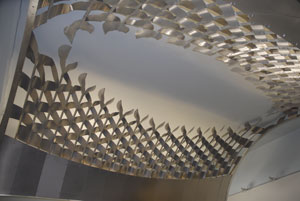 Aluminum Arched Trellis
Aluminum Arched Trellis
Artist: Kent Bloomer
Date: 2003
Material: Hammered aluminum
Location: Fair Haven School, 164 Grand Avenue
According to Guilford artist Kent Bloomer, the concept for this work centers on placement in the school entryway as students pass from bus to classroom. In this space small, hammered, aluminum leaf shapes transform into birds in flight, suggesting a "burst of sun, nature and flight" as the students pass underneath.
The stylized shapes of the birds are based on an endangered species called the kite, a bird of prey whose Florida numbers reached its lowest point in the late 1960s due to the ill effects of water management.
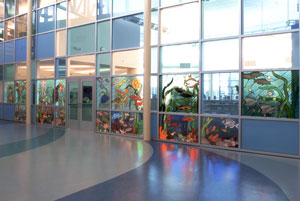 Circle of Life
Circle of Life
Artist: Liliana Mejia Sikorsky
Date: 2004
Material: Stained glass, fused glass
Location: John S. Martinez School Media Center, 100 James Street
Liliana Mejia-Sikorsky's glass wall featuring ocean life themes serves as the enclosure for the school's Media Center. Combining old and new glass technologies, the artist used stained glass, fused glass and colored glass to create the vibrant scenes of sea plants and animals floating in soft blue waves.
The technique used by Mejia-Sikorsky has been popular since the Middle Ages: pieces of colored glass are fused together with thin strips of lead and tin solder. Due to the fragile nature of the material, the glass panels were sandwiched between a layer of thermo-tempered glass, protecting the art glass and making the surface easy to clean.
The artist chose the theme of sea life based on the new schools proximity to the Mill River and Long Island Sound and researched the aquatic life with teachers at New Haven's Sound School for Maritime Studies. The school is comprised of small forms that reference the shape of a ship. Mejia-Sikorsky was born in Columbia, South America and presently lives in West Haven.
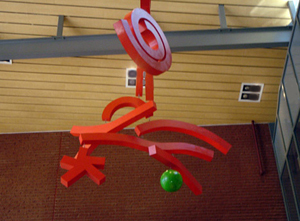 Fall
Fall
Artist: Sam Weiner
Date: 2009
Material: Wood Sculpture Installation
Location: Bishop Woods School, 1481 Quinnipiac Avenue
Sam Weiner’s work is one of the few purely abstract works of art commissioned under the Percent for Art program in New Haven. Over the past thirty years this New York-based artist has worked across various mediums, and been an educator, and a MacDowell Fellow (1991) and a Banff Center for Arts Fellow (1997). The hanging sculpture Wiener created for the lobby of Bishop Woods School consists of large pieces of wood painted bright red, which change direction due to air movement. From the center of the abstract red “arms” floats a green sphere, which the artist says “may be thought of as a seed, suggesting regeneration.” Though Wiener also says that “the predominant red of the branch forms, their motion and the single send sphere below, all suggest woods in the fall season” (hence the title of the work), “that’s as far as I want to go with suggestions of representation.”
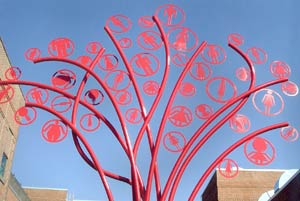 Tree of Life
Tree of Life
Artist: Douglas Kornfeld
Date: 2004-2005
Material: Steel
Location: Courtyard, Cliinton Avenue School, 293 Clinton Avenue
Douglas Kornfeld, a sculptor and educator from Cambridge , Massachusetts, designed a laser-cut steel sculpture of a tree for the courtyard of the renovated Clinton Avenue School. The artist chose to paint the sculpture one color to symbolize the unity of the differenty types of people represented in the medallions (leaves).
Kornfeld presented a two dimensional stylized form. Further calling attention to the standard signs or symbols upon which this work of art rests, Kornfeld employs the standard international symbols of male and female figures to represent people. His figures, though, have been altered to denote "types" of people and personalities. For example, some figures appear heavy, while some are thin, some are small while others are big. To try and capture psychological or emotional states, some figures have large heads, while others are minute.
Though the artist states in his proposal that the figures "celebrate diversity of the community without reference to peace, politics or religion," the title and subject of The Tree of Life is well-known in Judeo-Christian iconography, as the center of Eden, and as the connecting path between earth and heaven.
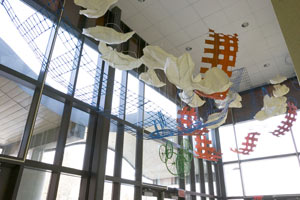 Going Places: Skyway to WOW!
Going Places: Skyway to WOW!
Artist: Nancy Cohen
Date: 2004
Material: Paper, wire, aluminum, wood
Location: Ross/Woodward School interior, 185 Barnes Avenue
Described by the artist as a spirited installation piece that provides "visual food for thought [which] reinforces a central lesson of the best of schools," Going Places Skyway to Wow! exists in two parts, attached hanging from the atrium ceiling of the new school's atrium.
Cohen designed her work to parallel the curving interior walls and the steel wave of the entryway, laying out track that captures the viewer's attention with movement and the use of rich primary colors. The aluminum and wood armatures of wheels, hoops and cloud-like forms were constructed in the artist's Jersey City studio, then covered in handmade papers produced by the Dieu Donne Papermill in New York City.
One of the discoveries students will find in the artwork is the insertion of different types of papers (graphic, notebook and construction) which Cohen hopes will keep viewers engaged. There are multiple angles from which to view the works, each presenting new visual compositions.
